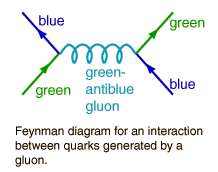    |
||||

Gluon - the exchange particle for the strong nuclear force |
||||
|
At A level you do not have to study the 'color' of quarks, but the board expect you to know that gluons are the exchange particle for the strong interaction. Gluons are the exchange particles for the 'colour force' between quarks. Therefore the gluon can be considered to be the fundamental exchange particle underlying the strong interaction between protons and neutrons in a nucleus. The short-range nucleon-nucleon interaction is considered to be a residual color force extending outside the boundary of the proton or neutron. In other words the gluon pulls the quarks together very strongly and part of the force field doing that is found around the quark arrangement and that is what holds nucleons together! That strong interaction was initially modeled by Yukawa as involving an exchange of pions, and indeed the pion range calculation was helpful in developing our understanding of the strong force. The pion was therefore said to be the exchange particle for the strong nuclear force and early A level examination questions require you to say that a pion is the exchange particle for the strong force. However we now say that the exchange particle for the strong force is the gluon.
The gluon Feynman diagram shows a blue quark being converted to a green one and vice versa. (You do not need to be able to draw or interpret these at A level). RangeThe range of the strong force is limited by the fact that the gluons interact with each other as well as with quarks in the context of quark confinement. These properties contrast them with photons, which are massless and of infinite range. The photon does not carry electric charge with it, while the gluons do carry the "color charge". Within their range of about a fermi, the gluons can interact with each other, and can produce virtual quark-antiquark pairs. The property of interaction with each other is very different from the other exchange particles, and raises the possibility of gluon collections referred to as "glueballs". The internal state of a hadron is viewed as composed of a fixed net number of quarks, but with a dynamic cloud of gluons and quark-antiquark pairs in equilibrium. Extracted from hyperphysics - a most excellent site - but beyond A level standard. |
||||
 |
||||



